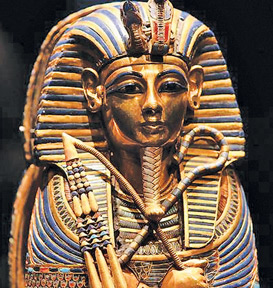King Tutankhamun did not die in chariot crash
New research indicates the boy king most likely died as a result of
genetic impairments which weakened his body
 A ‘virtual autopsy’ of King Tutankhamun has revealed that he is
unlikely to have died in a chariot crash, as has previously been
suggested, because he suffered from serious genetic physical
impairments. A ‘virtual autopsy’ of King Tutankhamun has revealed that he is
unlikely to have died in a chariot crash, as has previously been
suggested, because he suffered from serious genetic physical
impairments.
The autopsy, composed of over 2,000 computer scans, was carried out
alongside a genetic analysis of Tutankhamun’s family, which supports
evidence his parents were brother and sister.
Virtual scans showed that only one of the breaks occurred before he
died, while fractures in his skull and other parts of his skeleton were
made after the boy king was already dead - leading scientists to believe
he may have succumbed to an inherited illness.
Prof Albert Zink, head of the Institute for Mummies and Icemen in
Italy, said he was confident King Tutankhamum did not die as a result of
a chariot accident.
“It was important to look at his ability to ride on a chariot and we
concluded it would not be possible for him, especially with his
partially clubbed foot, as he was unable to stand unaided.
“We need further genetic analysis because that would give us more
insight into his conditions,” he said.
He said that the young royal’s death was most likely caused from his
being in a weakened state as a result of genetic impairments inherited
from his brother and sister parents.
“On the other hand he suffered from malaria so it is difficult to say
whether that may have been a serious factor in the cause of death,” prof
Zink said, emphasising there was still more research to be done.
Previous theories that the leader died after complications arising
from breaking his leg in a chariot crash were challenged as the autopsy
revealed the King’s weakened state, and club foot, meant he would have
been unlikely to have ever driven a chariot.
The evidence is backed up by the discovery of 130 used walking canes
in his tomb.
Ashraf Selim, an Egyptian radiologist, who is featured on the BBC
documentary said: “There is only one site where we can say the fracture
happened before he died and that is the knee”.
“It’s a big trauma. This fracture happened shortly before he died and
before embalming,” he said.
Evidence gathered over the years has painstakingly constructed a
clearer understanding of the Egyptian King, who ascended the throne in
1332BC at the age of nine or ten, ruling until his death in 1323 BC aged
19.Various theories have been suggested for his young death.
The prevalent notion for years was that he had been murdered, thanks
to a large hole found in the back of his skull.
However, advances in understanding Ancient Egyptian culture led
scientists to believe the hole was a result of the natural mummification
process, and the young leader’s death was instead due to complications
from a broken leg, which was exacerbated by malaria.
The discovery of his tomb in 1922 by Dr Howard Carter revived
interest in Ancient Egyptian culture and history, leading to the mask of
King Tut’s mummy becoming one of the most popular icons for the period.
- The Independent
|

